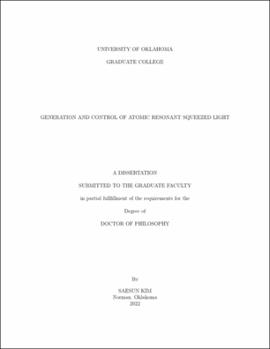| dc.description.abstract | Quantum metrology is a new emerging technology studying of extreme sensitive and high resolution measurement based on quantum mechanical principles such as quantum entanglement and squeezing, which can potentially revolutionize modern technology for defense and national security.
Squeezed light plays a fundamental role in quantum metrology due to its reduced noise properties. Recently, it was used to increase the sensitivity of the LIGO interferometer to measure gravitational waves and provide new ways to observe the universe. Additionally, a quantum advantage has also been demonstrated in other optical devices such as plasmonic sensors and quantum imaging. However, there are still many challenges and opportunities for squeezed light to be adopted to current sensors and other systems. Therefore, the focus of this dissertation is to extend the applicability of squeezed light to atomic sensors and enable a control of quantum noise. To extend the applicability of squeezed light to atomic systems, it must have a frequency close to or on atomic resonance and a narrow linewidth to obtain an efficient interaction with atomic ensembles. Therefore, there is substantial interest in generating narrowband squeezed light on atomic resonance. The successful demonstration of atomic resonance squeezed light and the effective control of the noise properties of squeezed light can enable improved sensitivity of atomic-based sensors and deterministic transfer of the quantum correlation between two distant atomic ensembles.
In the first part of the dissertation, we present three different approaches to generate two-mode atomic resonant squeezed light with a four-wave mixing (FWM) processes in hot $^{85}$Rb. First, we take advantage of the proximity of the energy levels in the D1 line of $^{85}$Rb and $^{87}$Rb to demonstrate the generation of resonant squeezed light with a non-degenerate FWM in which one mode is on resonance with the D1 $F=2$ to $F^\prime=2$ transition and the other mode is on resonance with the $F=1$ to $F^\prime=1$ transition in the D1 line of $^{87}$Rb. For this configuration, we obtain an intensity difference squeezing level of $-3.9$~dB. Moreover, the intensity difference squeezing increases to $-6.3$~dB and $-6.2$~dB when only one of the modes of the squeezed state is resonant with the D1 $F=2$ to $F^\prime=2$ or $F=1$ to $F^\prime=1$ transition of $^{87}$Rb, respectively.
Another approach used to generate resonant squeezed light is via the coupling with additional pump beam to enhance the atomic processes. We apply an optical beam to transfer population between the ground states, dress the atomic system, or saturate the transition to enhance FWM process. We measure $-0.8$~dB of intensity difference squeezing when both probe and conjugate are simultaneously on resonance with the D1 $F=3$ to $F^\prime=3$ transition of $^{85}$Rb and $-1$~dB of intensity difference squeezing when the probe is resonant with the D2 $F=2$ to $F^\prime=3$ transition of $^{87}$Rb.
While the first two approaches generate resonant squeezed light for certain transitions, there are still many transitions that we cannot reach with our techniques. To overcome this limitation, we dress the atomic state via an external DC electric field to increase the frequency tunability of the two-mode squeezed light. We design a vacuum chamber with parallel plates to apply large electric fields of up to $110$~kV/cm to the atomic vapor source. Our work increases the frequency tunability of the squeezed light to $600$~MHz, demonstrating the generation of squeezed light resonant with the D1 $F=3$ to $F^\prime=3$ transition of $^{85}$Rb.
In the second part of the dissertation, we discuss two different methods of controlling the properties of two-mode squeezed light to generate single-mode squeezed light and multipartite entangled light. We obtained a single-mode squeezed state with a squeezing level of $-2.9$~dB by transferring the intensity quantum correlations present in the twin beams to a single beam using a feedforward technique. In the last chapter, we introduce a novel scheme to generate scalable genuine multipartite entanglement. We show configurations of the proposed scheme that can generate genuine quadpartite, hexapartite, and octapartite entanglement, which we verify through a violation of the positive partial transpose (PPT) criterion.
The generation of resonant squeezed light using atomic ensembles overcomes several experimental difficulties associated with other sources and make it possible to study the interaction between atoms and quantum states of light. Thus, our work will be a building block for quantum metrology based on squeezed light, particularly important for atomic sensing and quantum information science. | en_US |

